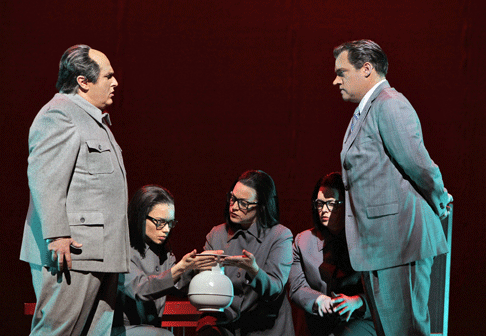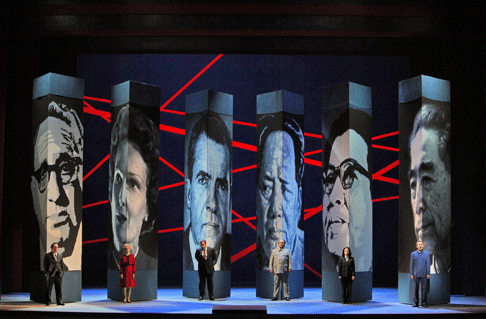It was an uncanny fit in the War Memorial opera house, our residual banking and energy tycoons superimposed onto our tech billionaires, the old guard and the young Turks all sitting there in our stodgy old opera house mesmerized by a brash young opera (well, young relative to our 400 year old repertory).
Not to mention Nixon and Mao, Pat and Chiang Ch’ing, Henry and Chou. How many ways could composer Adams find to make two against three, four against three, everything over anything go together and not go together during the three fleet hours it took a virtuoso orchestra to navigate this treacherous score?
Over this but more so within this score lies Alice Goodman’s libretto that juxtaposes mind-boggling and mind-numbing banalities with metaphors of grace and intelligence and flights of lyricism that float in and out of comprehension and are the motor of the mind-bogglingly richness of energy and color, ebb and swell, the sure sonic embodiment of one of the more bizarre moments of human history. And finally what it means. This seems to be found in a few tiny moments of personal reminiscences that are nothing and everything.
Nixon in China is a masterpiece, and if you did not know what theory of binary opposition is at least now you know what it feels like.
Of course there is the back story of the West once again discovering the East, though it dims as time goes on. It is history that will be vaguely known by few of the new generation of opera goers. What really was is no longer of concern to this opera that seems to have joined Simon Boccanegra in the core repertory (36 productions worldwide in its 25 years of existence). Nixon in China is now an operatically consecrated human document, not an historical document.
Like Verdi, Adams knows that politics are loud, and Nixon in China was plenty loud, belying its relatively modest resources — only double or triple winds and a reduced string contingent. But Adams adds a chorus of saxophones to traverse musical prerogatives, plus some rare sharp percussive sounds to throw listener sensibilities off-balance. It was already the digital age back in 1987 so there is a synthesizer, and there is electronic manipulation of all natural instrumental and vocal sound. Get it? — Adams’ amplifies his voices and orchestra!
He is thereby able to insert Wagner’s apocalyptic resolution into Madame Mao’s ballet with a richness maybe known only by 110 players in Bayreuth. Luckily next up this spring is Verdi’s Attila with Maestro Luisotti so there should not be too much of a sonic letdown.
Masterminding this cold war gˆtterd‰mmerung was Dutch conductor Lawrence Renes who imposed a sense of rhythmic precision that immediately gripped and never flagged over the duration, evoking sounds that made the excitement of space exploration in the late twentieth century as alive and provocative as its accompanying politics. It was masterful conducting.
 Simon O’Neill as Mao Tse-tung; Ginger Costa-Jackson, Buffy Baggott and Nicole Birkland as Mao’s secretaries; and Brian Mulligan as Richard Nixon
Simon O’Neill as Mao Tse-tung; Ginger Costa-Jackson, Buffy Baggott and Nicole Birkland as Mao’s secretaries; and Brian Mulligan as Richard Nixon
It was a cast of singers rather than singing actors. Some voices were larger than others, but with the help of sensitive sound design (amplification) all of these fine and beautiful voices melded magically with the sonorities created in the pit to create opera that was pleasing rather than provocative.
San Francisco Opera regular Brian Mulligan effected a fairly reasonable profile as Richard Nixon but captured nothing of the charisma of such a political personality. Tenor Simon O’Neill achieved a Mao of effective proportion though without messianic sense. Both soprano Maria Kanyova and baritone Chen-Ye Yuan are making a sizable careers as Pat Nixon and Chou En-lai having already performed the roles in many productions around the country. Mr. Yuan brings particular sensitivity and solidity to Chou En-lai. Patrick Carfizzi did not find a persona as Henry Kissinger though he provided good fun. Watch soprano Hye Jung Lee sing Madame Mao’s aria on YouTube, www.youtube.com/watch?v=IwHxvRJ_vPMto, to understand why she got the role even though she is way too young.
As in the recent production of The Death of Klinghoffer at the English National Opera the biggest and finest moments of lyric transport occurred not vocally but in dance. The relentless obscurity of the Alice Goodman libretto suspended, Adams unfettered by need to support vocal line, music and movement united to become one in the plight of the poor peasant girl, splendidly danced en point by ballerina Chirharu Shibata to the choreography of Wen Wei Wang, supported by her savior, dancer Bryan Ketron.
 Patrick Carfizzi as Henry Kissinger, Maria Kanyova as Pat Nixon, Brian Mulligan as Richard Nixon, Simon O’Neill as Mao Tse-tung, Hye Jung Lee as Madame Mao and Chen-Ye Yuan as Chou En-lai
Patrick Carfizzi as Henry Kissinger, Maria Kanyova as Pat Nixon, Brian Mulligan as Richard Nixon, Simon O’Neill as Mao Tse-tung, Hye Jung Lee as Madame Mao and Chen-Ye Yuan as Chou En-lai
The performance was an un-nerving experience, exacerbated by the absence of its primary creator, Peter Sellers. It was after all his idea. It is inexplicable why San Francisco Opera eschewed the genius of this major American director for its premiere of one of the most important operas of the twentieth century.
As it was San Francisco Opera opted for a production from Vancouver Opera that most recently visited Kansas City. It is a fine, good looking production of theatrical savvy by Canadian director Michael Cavanagh. It is straightforward and workmanlike. It did not approach the opposites of the abstract, structuralist theatrical world of Sellers, Goodman and Adams.
Michael Milenski
image=http://www.operatoday.com/Nixon-2.gif
image_description=Brian Mulligan as Richard Nixon [Photo by Cory Weaver. courtesy of San Francisco Opera]
product=yes
product_title=John Adams: Nixon in China
product_by=Richard Nixon: Brian Mulligan; Pat Nixon: Maria Kanyova; Mao Tse-tung: Simon O’Neill; Madame Mao Tse-tung: Hye Jung Lee; Chou En-lai: Chen-Ye Yuan; Henry Kissinger: Patrick Carfizzi; Nancy T’ang: Ginger Costa-Jackson; Second Secretary: Buffy Baggott; Third Secretary: Nicole Birkland; Wu Ching-Hua (dancer): Chiharu Shibata; Hung Ch’ang-Ch’ing (dancer): Bryan Ketron. Chorus and Orchestra of San Francisco Opera. Conductor: Lawrence Renes; Stage Director: Michael Cavanagh; Set Designer: Erhard Rom; Costume Designer: Parvin Mirhady; Lighting Designer: Christopher Maravich; Choreographer: Wen Wei Wang. San Francisco Opera, War Memorial Opera House, June 8, 2012
product_id=Above: Brian Mulligan as Richard Nixon
Photos by Cory Weaver. courtesy of San Francisco Opera